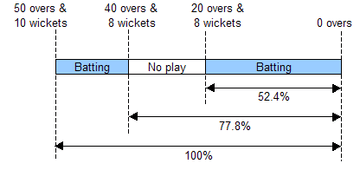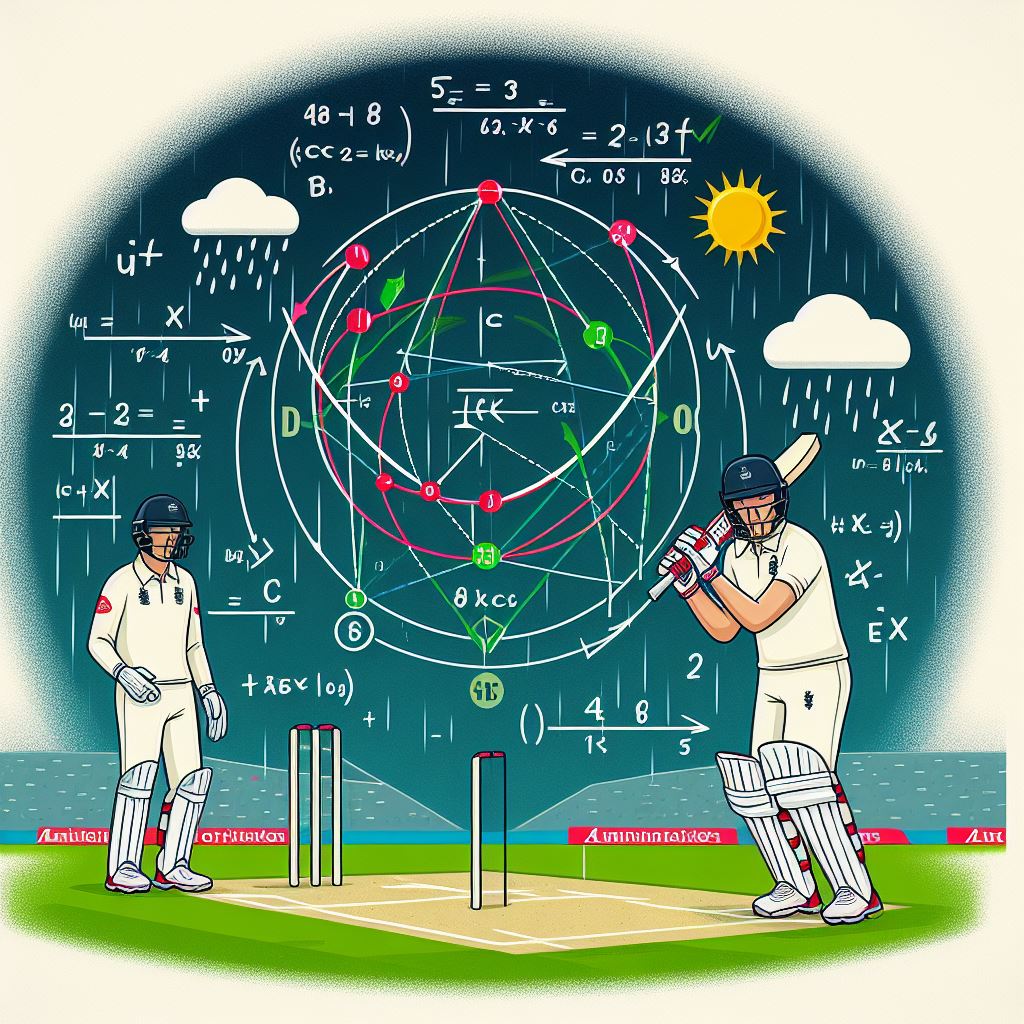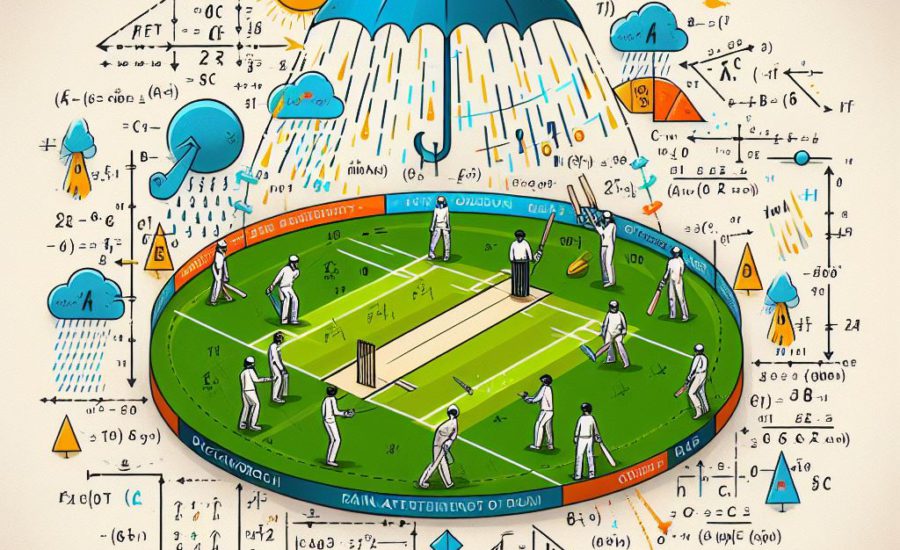Cricket, the beloved gentleman’s game, is not immune to the unpredictable forces of nature. Rain showers can often dampen the spirit of both players and fans alike, disrupting matches and leaving outcomes hanging in the balance. But fear not! The Duckworth-Lewis-Stern (DLS) method swoops in to save the day, bringing order and fairness to rain-affected cricket matches. In this blog post, we will demystify the DLS Method in Cricket by unraveling its rules and calculations. So grab your umbrella as we embark on a journey through this fascinating system that ensures no raindrop goes unnoticed on the field!
What is the DLS Method in Cricket?

The Duckworth-Lewis-Stern (DLS) method is a mathematical system used in cricket to adjust targets in rain-affected matches. It ensures fairness by considering the resources available to the batting side and weather interruptions, providing a recalculated target for teams in limited-overs formats. The DLS method has become a vital tool in managing the impact of weather conditions on the outcome of cricket matches.
What is the DLS Method in Cricket? It’s a complex yet ingenious system used to calculate revised target scores in rain-affected matches. When rain interrupts play, the DLS method steps in to level the playing field by adjusting targets based on various factors such as overs lost and resources available. Developed by statisticians Frank Duckworth and Tony Lewis, this method ensures that both teams have a fair chance of winning despite unpredictable weather conditions. So, how does it work? Let’s dive deeper into the intricacies of this fascinating cricketing phenomenon.
The DLS method takes into account not only the number of overs remaining but also considers wickets lost and runs scored. By analyzing these factors, it calculates a par score which represents what a team should be at any given point based on their performance thus far. This par score then serves as a benchmark for determining the revised target for the chasing team after an interruption due to rain or bad light. Understanding these calculations plays a crucial role in comprehending how matches are decided when Mother Nature decides to interfere with our favorite sport.
Explaining the DLS Method

The DLS Method in cricket is a complex formula used to calculate revised targets in rain-affected matches. Understanding this method can be quite confusing for fans and even players themselves. So, let’s break it down and demystify the DLS Method.
Essentially, the DLS Method takes into account various factors such as overs played, wickets lost, and run rate to determine a revised target for the team batting second. It ensures that both teams have an equal opportunity to win despite interruptions caused by rain or other external factors. By using this method, matches can continue with minimal disruptions while maintaining fairness.
However, it’s important to note that the DLS Method isn’t foolproof and has faced criticism over the years. Critics argue that it sometimes gives an advantage to one team over another or doesn’t accurately reflect the true potential of a team. Despite its limitations, though, the DLS Method remains widely accepted in international cricket as a means of ensuring fair play in rain-affected matches.
Origin and Purpose of the DLS Method
Cricket is a game that can be heavily influenced by weather conditions. Rain interruptions can disrupt the flow of a match and have a significant impact on the outcome. This is where the DLS (Duckworth-Lewis-Stern) method comes into play.
The DLS method was developed by Frank Duckworth and Tony Lewis in the 1990s as an alternative to the traditional rain rules. Their goal was to create a fair and accurate way to calculate target scores for teams batting second in rain-affected matches. The method has since been updated and renamed as the Duckworth-Lewis-Stern method, incorporating improvements suggested by Steven Stern.
The purpose of the DLS method is to provide both teams with a realistic chance of winning based on their performance up until the interruption. It takes into account factors such as wickets lost, overs remaining, and run rate at that stage of the match. By using this formulaic approach, it aims to ensure fairness and competitiveness in rain-affected games.
Understanding why and how the DLS method came about helps us appreciate its significance in modern cricket. It’s not just another set of rules; it’s a tool designed to level out playing fields affected by unpredictable weather conditions!
Key Differences between Par Score and Target Score
The DLS method in cricket introduces two important terms: the par score and the target score. While they may sound similar, there are key differences between these two scores.
The par score is calculated based on the number of overs completed by both teams at the time of rain interruption. It takes into account various factors such as wickets lost, run rate, and average scoring rates for different stages of an innings.
On the other hand, the target score is what the team batting second needs to achieve in order to win. This score is adjusted from the par score based on factors like reduced overs and resources available to each team.
Understanding these differences between par score and target score helps determine a fair outcome in rain-affected matches where traditional methods cannot be applied. The DLS method ensures that teams have a balanced opportunity to compete despite interruptions caused by inclement weather conditions.
How Does the DLS Method Work?
The DLS Method, also known as the Duckworth-Lewis-Stern Method, is a complex mathematical formula used in cricket to determine revised target scores in rain-affected matches. So how does it actually work? Well, first, the calculation of batting resources comes into play. This involves taking into account the number of overs remaining and the number of wickets lost by the batting team.
Once the batting resources are determined, they are converted into a revised target score for the team batting second. This conversion takes into consideration various factors such as run rate, scoring patterns, and potential acceleration or deceleration of runs based on available resources. This method aims to provide a fair way for teams to continue playing and have an equal chance at winning despite weather interruptions.
Calculation of Batting Resources
The calculation of batting resources is a crucial aspect of the DLS method in cricket. It helps determine the revised target score for the team batting second in rain-affected matches. But how exactly are these resources calculated?
Well, it involves assessing various factors such as the number of overs left to be bowled, wickets lost by the batting team, and their current run rate. These elements are then used to calculate a percentage known as “resources remaining.” This percentage represents how much firepower the batting team has at its disposal to chase down a revised target.
To further explain, let’s say a team has 20 overs left and they have lost 2 wickets with a run rate of 6 runs per over. Based on these figures, their resource percentage may be determined as 70%. This means that they still have approximately 70% of their original batting potential available to them.
By calculating these batting resources accurately, officials can ensure fairness and provide teams with an adjusted target that reflects both the game situation and weather conditions. So next time you watch a rain-interrupted match, remember that behind those calculations lies an intricate system striving to maintain balance in unpredictable circumstances!
Conversion of Batting Resources to Target Score
The DLS method in cricket is not just about calculating the par score; it also involves converting batting resources into a target score. This conversion takes into account the number of overs remaining and the wickets lost by the team batting second. It aims to level the playing field and ensure a fair result despite rain interruptions.
To convert batting resources into a target score, various factors are considered, such as run rate at each stage of an innings, average scoring rates for different phases, and expected acceleration or deceleration based on historical data. These calculations help determine how many runs a team should aim for within their limited available resources.
The conversion process may seem complex, but it plays an essential role in ensuring that both teams have an equal opportunity to win when rain affects matches. By considering these factors and making adjustments accordingly, the DLS method tries its best to provide a fair outcome even under challenging weather conditions.
Examples of DLS Method Application
One of the best ways to understand how the DLS method is applied in cricket matches is through examples. Let’s take a look at a couple of scenarios where rain interrupts play and the DLS method comes into play.
In a match between Team A and Team B, Team A sets a target score of 250 runs in 50 overs. Unfortunately, rain disrupts the game after only 30 overs have been completed, with Team A scoring 150 runs for the loss of two wickets. According to the DLS method calculations, their batting resources are considered to be at around 60%. The revised target score for Team B would then be determined based on this percentage and their remaining overs.
Another example could involve a situation where both teams have played an equal number of overs before rain interruption. If Team C has scored 200 runs in their allotted 50 overs without losing any wickets, but rain forces an early end to the match during Team D’s innings when they are at just 120 runs for four wickets down with five overs left. In this case, using the DLS method, it can be calculated that Team C had utilized around 80% of their batting resources while setting up their total. This percentage will then determine what adjusted target score will be set for Team D if they were able to complete all fifty overs.
Understanding these examples helps shed light on how crucial it is to accurately calculate and apply the DLS method during rain-affected cricket matches.
Impact of Rain on Cricket World Cup Matches
Rain can be a game-changer in cricket, especially during high-stakes events like the Cricket World Cup. When rain interrupts play, it becomes crucial to determine the outcome of the match. This is where the Duckworth-Lewis-Stern (DLS) method comes into play.
The DLS method takes into account various factors such as overs played, wickets lost, and run rate to calculate a revised target for the team batting second. The aim is to ensure that both teams have an equal chance of winning despite any interruptions caused by rain. It’s a complex calculation that relies on statistical data and algorithms to provide a fair result in rain-affected matches.
How Rain-Affected Matches Are Decided?
In rain-affected cricket matches, the Duckworth-Lewis-Stern (DLS) method comes into play to ensure fairness. This mathematical formula adjusts target scores based on the available resources and overs for the batting side, accounting for interruptions due to weather. The DLS method has become a crucial tool in determining revised targets, allowing for a balanced and equitable resolution in limited-overs formats when matches are affected by rain or other adverse weather conditions.

Rain can be a game-changer in cricket, especially when it comes to deciding the outcome of matches. When rain interrupts play, officials have to determine how the match will be decided. The decision-making process involves considering various factors such as the number of overs played, target scores, and run rates. It’s not always an easy task for the officials, as they must ensure fairness and maintain the integrity of the game.
In rain-affected matches, there are specific rules that come into play. If both teams have had an equal opportunity to bat for at least 20 overs (or any other predetermined minimum number), then a result is possible based on Duckworth-Lewis-Stern (DLS) calculations. These calculations take into account various parameters like current score, wickets lost, and resources available to each team. Based on these calculations, a revised target score is set for the team batting second if they haven’t completed their innings before rain interrupted play.
It’s important to note that every situation is unique; therefore, no two rain-affected matches are decided in exactly the same way. The DLS method provides a framework for determining revised targets and ensuring fair outcomes despite interruptions caused by inclement weather conditions like rain or bad light.
Overview of DLS Method in Cricket World Cup 2023
The DLS Method has become an integral part of cricket, especially during rain-affected matches. In the upcoming Cricket World Cup 2023, this method will play a crucial role in determining outcomes when the weather disrupts gameplay. It is important for both players and fans to understand how the DLS Method works and its implications on match results.
During the Cricket World Cup 2023, if rain interrupts play, the DLS Method will be used to decide target scores for teams batting second. This method takes into account various factors such as overs lost due to rain and resources available to each team. By applying complex calculations based on historical data, it provides a fair assessment of what would have been a competitive score had there been no interruptions.
Stay tuned for more information on how the DLS Method will be implemented in Cricket World Cup 2023 matches! Understanding this method is vital for both players and spectators alike as they follow their favorite teams’ progress throughout the tournament.
Understanding the Calculations of DLS Method
The calculations involved in the DLS method might seem complex at first, but they are actually quite logical and straightforward. Let’s break it down step by step.
The DLS method calculates the batting resources available to a team based on their overs remaining and wickets in hand. This is done to determine how many runs the team would have been expected to score if not for rain interruptions. These batting resources are expressed as a percentage.
Next, these batting resources are converted into a target score for the team batting second. The formula used takes into account factors like previous scoring rates, pitch conditions, and run rate required by the chasing team. This ensures that both teams have an equal opportunity to achieve victory despite weather disruptions.
Understanding the calculations of the DLS method is crucial in comprehending how rain-affected matches are decided in cricket. By assessing batting resources and converting them into target scores, this system ensures fairness and maintains excitement even when rain tries to dampen spirits on match day.
Step-by-Step Process of DLS Method Calculation
The DLS Method calculation may seem complex, but it follows a step-by-step process to determine the revised target score in rain-affected cricket matches. First, the total resources available for the team batting first are calculated based on overs played and wickets lost. Then, these resources are converted into a target score using a mathematical formula that considers run rate and number of overs remaining.
Next, factors such as interruptions due to rain or other reasons are taken into account to adjust the target score accordingly. The calculations consider various scenarios and aim to provide a fair outcome for both teams despite weather disruptions. This meticulous process ensures that matches can continue with adjusted targets that reflect the current game situation while considering the impact of rain on play.
Factors Considered in DLS Method Calculation
The DLS method takes into account several factors when calculating the revised target score in rain-affected cricket matches. These factors include the number of overs remaining, the current run rate, and the wickets lost by the batting team.
The number of overs remaining plays a crucial role in determining the revised target score. The fewer overs there are left to play, the higher the required run rate becomes for both teams. This ensures that teams have a fair chance to chase down or set a competitive total within limited playing time.
The current run rate is taken into consideration. If a team has been scoring at an impressive pace before rain interrupts play, they will be allocated more runs compared to their opponents who may have struggled with their batting performance.
Additionally, wickets lost by the batting team also influence how targets are adjusted under DLS calculations. Losing early wickets can significantly impact a team’s ability to maintain momentum and reach a competitive total within reduced overs.
By considering these key factors – remaining overs, current run rate, and wickets lost –the DLS method aims to create an equitable outcome for both teams in rain-affected matches without compromising on competitiveness or fairness.
Significance of Net Run Rate in DLS Method
The significance of net run rate in the DLS Method cannot be overlooked. It plays a crucial role in determining the outcome of rain-affected matches.
In the context of the DLS Method, net run rate helps decide which team has performed better during their respective innings. This is important because if a match is interrupted due to rain, it becomes essential to assess each team’s performance based on scoring rates rather than total runs. Net run rate allows for a fair comparison and ensures that teams are not disadvantaged or advantaged by external factors such as weather conditions. It adds an additional layer of fairness and accuracy to the calculations under the DLS Method.
Exploring the Limitations and Criticisms of DLS Method
While the DLS method has been widely adopted in cricket to determine revised targets in rain-affected matches, it is not without its limitations and criticisms. One common criticism is that the method does not always accurately reflect the true state of play, especially when a team loses fewer wickets than expected or when a batsman’s individual performance has a significant impact on the game.
Another limitation is that the calculation of target scores can sometimes lead to unfair outcomes, particularly if a team batting second requires an unrealistic run rate due to adjustments made by the DLS method. Additionally, some critics argue that relying solely on net run rate as a tiebreaker in rain-affected matches may not provide a fair representation of teams’ overall performances.
While the DLS method serves as a valuable tool for determining revised targets in rain-affected matches, it is important to acknowledge its limitations and consider alternative methods that could address these concerns.
Criticisms of DLS Method in Cricket
The DLS method in cricket, although widely used to determine target scores in rain-affected matches, has faced its fair share of criticism. One major criticism is that it can lead to unfair outcomes and favor the team batting second. This is because teams batting second have the advantage of knowing the revised target from the start of their innings, while teams batting first do not have this luxury.
Another criticism is that the DLS method does not always take into account individual player performances or game situations accurately. It relies heavily on mathematical calculations and assumes a linear progression of run-scoring throughout an innings. However, cricket is a dynamic sport where momentum shifts and partnerships can greatly impact a team’s chances of winning. Critics argue that these factors should be considered more effectively in determining revised targets.
While the DLS method has been instrumental in providing fair outcomes in rain-affected matches over the years, it still faces scrutiny for potentially favoring one side over another and overlooking crucial aspects of gameplay dynamics. As with any system, there will always be room for improvement and alternative methods may need to be explored to address these criticisms effectively.
Alternative Methods to DLS in Rain-Affected Matches
When it comes to rain-affected cricket matches, the Duckworth-Lewis-Stern (DLS) method has been the go-to formula for calculating revised targets. However, over the years, there have been criticisms and calls for alternative methods that could potentially provide fairer outcomes.
One such alternative is the VJD (V Jayadevan) method, which takes into account various factors like wickets in hand and run-rate at different stages of an innings. This method aims to offer a more accurate reflection of the game’s state before rain interruption. Another proposed approach is called “Percentage Method,” where teams are awarded points based on their performance up until the interruption point. These alternatives continue to be debated among cricket experts and fans alike, as everyone seeks a solution that ensures fairness and maintains excitement in rain-affected matches.
DLS Method FAQs
As with any complex topic, the DLS Method in cricket can raise a lot of questions. Here are some frequently asked questions to provide further clarity:
No, the DLS Method is also employed in domestic cricket matches when rain or other interruptions occur.
Yes, the DLS Method can be used in both limited-overs and Twenty20 matches.
If weather conditions prevent a Super Over from being completed, the result will be determined by applying the DLS Method.
The ICC continually reviews and refines its playing conditions, including methods for determining outcomes in rain-affected matches. The aim is always to ensure fairness and accuracy while maintaining simplicity.
While no system can perfectly predict match outcomes affected by weather interruptions, the implementation of historical data and statistical analysis makes the DLS method as reliable as possible within its limitations.
It’s important to remember that while rules and calculations may seem complicated at first glance, they exist to create fair outcomes even when nature disrupts play. The goal of cricket authorities remains centered on providing an exciting game for players and fans alike while ensuring fairness throughout all aspects of play.
So next time you’re watching a thrilling cricket match that gets interrupted by Mother Nature’s whims, you’ll have a deeper understanding of how decisions are made using the fascinating world of mathematics known as the Duckworth-Lewis-Stern (DLS) method!





